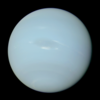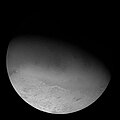William Lassell
William Lassell | |
|---|---|
 | |
| Born | 18 June 1799 Bolton, England |
| Died | 5 October 1880 (aged 81) Maidenhead, England |
| Known for | Discovered the moons Triton, Hyperion, Ariel and Umbriel |
| Awards |
|
| Scientific career | |
| Fields | Astronomer |
William Lassell (18 June 1799 – 5 October 1880) was an English merchant and astronomer.[1][2][3][4][5][6] He is remembered for his improvements to the reflecting telescope and his ensuing discoveries of four planetary satellites.
Life
[edit]William Lassell was born in Bolton, Lancashire, on 18 June 1799. He received his early education in Bolton and later attended Rochdale Academy..[7] After the death of his father, William Lassell was apprenticed to a merchant in Liverpool from 1814 to 1821. He later made his fortune as a beer brewer, which afforded him the means to pursue his passion for astronomy. He built an observatory at his house "Starfield" in West Derby, a suburb of Liverpool. There he had a 24-inch (610 mm) aperture metal mirror reflector telescope (aka the "two-foot" telescope), for which he pioneered the use of an equatorial mount for easy tracking of objects as the Earth rotates. He ground and polished the mirror himself, using equipment he constructed. The observatory was later (1854) moved further out of Liverpool, to Bradstones.
In 1846, Lassell discovered Triton, the largest moon of Neptune, just 17 days after the discovery of Neptune itself by German astronomer Johann Gottfried Galle, using his self-built instrument.[8][9][10] In 1848, he independently co-discovered Hyperion, a moon of Saturn.[9][11] In 1851 he discovered Ariel and Umbriel, two moons of Uranus.
In 1855, he built a 48-inch (1,200 mm) telescope, which he installed in Malta because of the observing conditions that were better than in often-overcast England. While in Malta his astronomical observing assistant was Albert Marth. On his return to the UK after several years in Malta, he moved to Maidenhead and operated his 24-inch (610 mm) telescope in an observatory there. The 48-inch telescope was dismantled and was eventually scrapped.[12] The 24-inch telescope was later moved to Royal Observatory, Greenwich in the 1880s, but eventually dismantled.[9]
Lassell was a Fellow of the Royal Astronomical Society (FRAS) from 1839, won the Gold Medal of the Royal Astronomical Society in 1849, and served as its president for two years starting in 1870.[13] He was elected a Fellow of the Royal Society (FRS) in 1849 and won their Royal Medal in 1858.[14] Lassell was also a Fellow of the Royal Society of Literature (FRSL).[15] He was furthermore elected an honorary Fellow of the Royal Society of Edinburgh (HonFRSE) and of the Society of Sciences of Upsala, and received an honorary LL.D. degree from the University of Cambridge in 1874.[16]
Lassell died in Maidenhead in 1880 and is buried at St. Luke's Church.[17] Upon his death, he left a fortune of £80,000 (roughly equivalent to £10,100,000 in 2023). His telescope was presented to the Royal Observatory in Greenwich.
The crater Lassell on the Moon, a crater on Mars, the asteroid 2636 Lassell and a ring of Neptune are named in his honour. At the University of Liverpool the William Lassell prize is awarded to the student with the highest grades graduating the B.Sc. program in Physics with Astronomy each year.[18][19]
Obituaries
[edit]- Astronomical Register, 18 (1880), p.284[20]
- Nature, 22 (1880), p.565[21]
- The Observatory, 3 (1880), p.587[22]
- Monthly Notices of the Royal Astronomical Society, 41 (1880), p.188[23]
See also
[edit]References
[edit]- ^ . Dictionary of National Biography. London: Smith, Elder & Co. 1885–1900.
- ^ AN 98(1881) 108 (in German)
- ^ "William Lassell". Monthly Notices of the Royal Astronomical Society. 41 (4): 188–191. 1881. Bibcode:1881MNRAS..41..188.. doi:10.1093/mnras/41.4.188.
- ^ Huggins, Margaret Lindsay (1880). "The late Mr. William Lassell, LL.D., F.R.S.". The Observatory. 3 (43): 587–590. Bibcode:1880Obs.....3..586H.
- ^ "The Late Mr. Lassell". Astronomical Register. 18 (215): 284–285. 1880. Bibcode:1880AReg...18..284. Retrieved 8 November 2015.
- ^ McFarland, John (2014). "Lassell, William". In Hockey, Thomas; Trimble, Virginia; Williams, Thomas R. (eds.). Biographical Encyclopedia of Astronomers. New York: Springer Publishing. pp. 1281–1283. doi:10.1007/978-1-4419-9917-7_828. ISBN 978-1-4419-9917-7.
- ^ Biographical Index of Former Fellows of the Royal Society of Edinburgh 1783–2002 (PDF). The Royal Society of Edinburgh. 2006. ISBN 0-902-198-84-X. Archived from the original (PDF) on 4 March 2016. Retrieved 23 July 2016.
- ^ Smith, Robert W. (1983). "William Lassell and the Discovery of Neptune". Journal for the History of Astronomy. 14: 30–32. Bibcode:1983JHA....14...30S. doi:10.1177/002182868301400102. S2CID 116099804. Retrieved 14 November 2015.
- ^ a b c "The Royal Observatory Greenwich – where east meets west: Telescope: The Lassell 2-foot Reflector (1847)". www.royalobservatorygreenwich.org. Retrieved 28 November 2019.
- ^ Smith, Robert W.; Baum, Richard (1984). "William Lassell and the Ring of Neptune: a Case Study in Instrumental Failure". Journal for the History of Astronomy. 15 (1): 1–17. Bibcode:1984JHA....15....1S. doi:10.1177/002182868401500101. S2CID 116314854. Retrieved 14 November 2015.
- ^ "In Depth | Hyperion". NASA Solar System Exploration. Retrieved 29 November 2019.
- ^ Lassell, William (1877). "Mr. Lassell's Great Reflector". The Observatory. 1 (6): 178–179. Bibcode:1877Obs.....1..178L. Retrieved 17 November 2015.
- ^ Herschel, John (1850). "An Address Delivered at the Annual General Meeting of the Royal Astronomical Society, February 9, 1849, on Presenting the Honorary Medal to William Lassell, Esq. of Liverpool". Memoirs of the Royal Astronomical Society. 18: 192–200. Bibcode:1850MmRAS..18..192H. Retrieved 14 November 2015.
- ^ "Library and Archive Catalogue". Royal Society. Retrieved 30 December 2010.[permanent dead link]
- ^ On a Method of Supporting a large Speculum, free from sensible Flexure, in all Positions – website Google Books
- ^ Former Fellows of the Royal Society of Edinburgh 1783–2002 Archived 4 March 2016 at the Wayback Machine – website of the Royal Society of Edinburgh
- ^ [1] Archived 13 March 2012 at the Wayback Machine HistoryTrail.pdf (St. Luke's Church)
- ^ "Physics Pre-Graduation Event 2017". Department of Physics, University of Liverpool. Retrieved 31 October 2017.
- ^ "Congratulations to all of our 2014 Physics graduates". Department of Physics, University of Liverpool. Retrieved 31 October 2017.
- ^ "1880AReg...18..284. Page 284". Astronomical Register. 18. 1880. Bibcode:1880AReg...18..284. Retrieved 15 November 2023.
- ^ Huggins, William (October 1880). "Nature Obituary" (PDF). Nature. 22 (572): 565–566. doi:10.1038/022565a0.
- ^ Huggins, M. L. (1880). "1880Obs.....3..586H Page 587". The Observatory. 3. Bibcode:1880Obs.....3..586H. Retrieved 15 November 2023.
- ^ "1881MNRAS..41..188. Page 188". Monthly Notices of the Royal Astronomical Society. 41. 1881. Bibcode:1881MNRAS..41..188.. doi:10.1093/mnras/41.4.188.
External links
[edit]- Biography and other topics Archived 2 August 2020 at the Wayback Machine
- Short biography and pictures
- Biography and technical detail of telescopes Archived 11 May 2023 at the Wayback Machine
- 1799 births
- 1880 deaths
- People from Bolton
- 19th-century English astronomers
- Neptune
- Uranus
- Saturn
- Recipients of the Gold Medal of the Royal Astronomical Society
- Fellows of the Royal Society
- Royal Medal winners
- Discoverers of moons
- Presidents of the Royal Astronomical Society
- Fellows of the Royal Society of Literature
- Members of the Royal Society of Sciences in Uppsala


